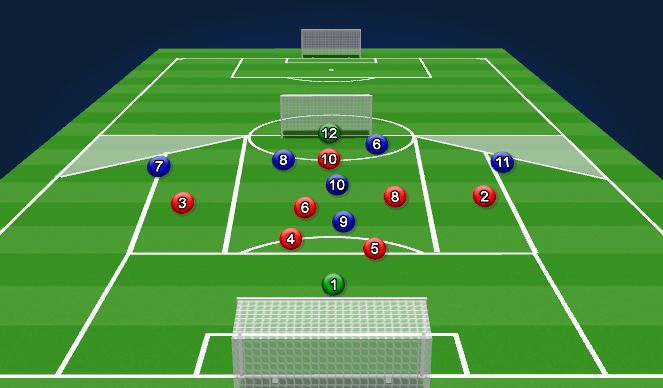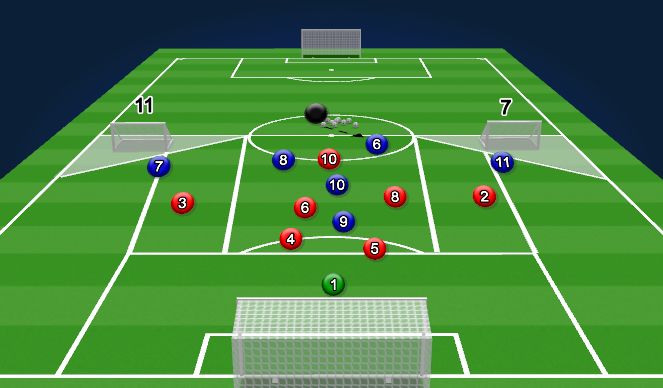Football/Soccer Session (Academy Sessions): UEFA B Session 3- Defending The Lines and Stopping the Opposing #10

Profile Summary

| Name: | Brett Laffien |
|---|---|
| City: | Vero Beach |
| Country: | United States of America |
| Membership: | Adult Member |
| Sport: | Football/Soccer |
Description
Organization (Practice Layout & Transition)
Both teams will be played using one whole half.
Equipment:
Flat markers will divide the pitch into 5 zones.
Cones will taper off the 2 corners of the field in the blues defensive half.
Blue team will be managed.
Red team will be coached (focused team).
Blue team plays a 2-2-3
Red team plays a 4-2-1
Blue team will be given instructions to create problems for the red team.
Red's focus is on not allowing the blue #10 to get on the ball. If the #10 gets on the ball, how quickly can they win it off of him?
Welsh Way Principles:
Fast Pressure on the Ball
Protect the Middle
Stay Narrow and Compact
Protect the Space Behind
Walkthrough if the blue #10 attacks centrally.
Walkthrough if the blue #10 attacks in half spaces.
Walkthrough if the blue #10 makes a run in behind.
Tactical Objectives:
Block Central Area
How? Stay Compact
Show Away From Goal
How? Body Shape
Stop Switches of Play
How? Contain in one half/Cut off switch
Protect the Space Behind
How? Apply Pressure on the Ball

See the guidance at the top of this page to understand why you are not seeing interactive Football/Soccer images.

SSG (30 mins)
Adaptations (Progressions & Regressions):
Ball will start from the Blue teams keeper (12).
Challenges, Conditions or Targets:
1.The Blue 10 can only work in the central zone.
Can the red team stay compact centrally?
2. The Blue 10 can work in the half space.
Can the red team shift together and stay compact?
3. The Blue 10 can work in the wide space.
Can the read team shift out wide with the opposite outside back shifting in to cover the middle?
4. No restrictions. All zones are open for the 10.
Can the red team keep an eye on the blue number 10 and move as a unit together? Can the CM's communicate with the CB? and vise versa.









 Play animation
Play animation Play step-by-step
Play step-by-step Repeat (toggle)
Repeat (toggle) Full Screen
Full Screen Pause
Pause Stop
Stop
Specific Practice (30 mins)
Adaptations (Progressions & Regressions):
The red teams goal is to not let the blue #10 get on the ball.
If the red team wins possession they can score on the mini goals representing the 11,7.
The blue teams goal is to score on the big goal by getting the ball into the #10 first.
Coach will play the ball into the blue team. If a goal is scored or the ball goes out the play always resets with the coach playing the ball to the blue team.
Challenges, Conditions or Targets:
Challenge 1: the blue 10 must stay in the central zone. This will make the blue team attack centrally. As the blue team attacks centrally, can the red team stay compact and defend the middle?
The back line (2,3,4,5) must stay compact. The central midfielders (6&8) have the responsibility to initially mark the #10. If the #10 tries to drop into the blue center backs the 8 must step and apply pressure. If the #10 tries to find space between the midfield and defense the 6 will pick up the responsibility of defending them. If the #10 makes a run in between or behind the centerbacks. The free centerback (one should be marking the #9) will shut down the #10.
Challenge 2: the blue #10 can only receive the ball in the half space. This allows the #10 to move horizontally across the pitch. If the ball moves out wide and the #10 shifts into the half space, can the red team shift appropriately to defend the #10 in the half space? The red team's primary goal is not to defend the wide space but to not let the #10 get on the ball in the half space.
The back line must still be compact as they shift from side to side. If the blue 7 gets the ball in the wide space, the red 3 must stay within the half space (between the edge of the box and the left side of the arch on the 18). Their role is to force the ball out wide or back. The central group (4,5,6,8) will shift to where the 4,6 are in the half space while the 5,8 cover the left side of the center zone. The 2 shifts in and drops to cover the right side of the center zone.
Challenge 3: the blue #10 must make runs beyond the defense. The blue team will look to play long/through ball to the #10 looking to make a run beyond the defense. If this happens, can the midfield communicate clearly that the #10 is passing them and going toward the defense? Can the defenders recognize the deep run and begin to drop off to anticipate the long ball?
The red 6 or 8 must mark the #10 while they are playing in the midfield, depending on what side the #10 is on. They have two options when the #10 starts to make a run behind. They can either pass the #10 on to the defense or follow the run themselves. If they are marking the #10 and they are heading to an open centerback they can communicate with the player to pick up the run. If the centerback is already marking a forward or striker they must follow the #10's run in behind.
Challenge 4: No movement restriction on the blue #10. Their job is to find space anywhere they can on the field. Can the red team apply pressure when the #10 drops? Can the red team shift as the #10 moves out wide? Can the red team drop as the #10 makes a run in behind? Can they stay compact as a unit?
Challenge 5: Assign the red #6 or #8 to man mark the blue #10. Can they stick to the #10 and shut down everywhere they go? As the player marking the #10 follows and get pulled out of position, can the other players stay compact/fill the the gap let by that player?